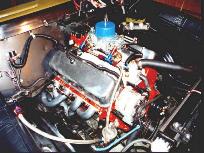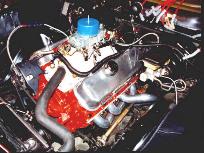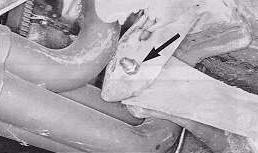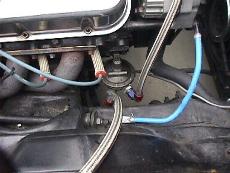Big
Block Chevy in a G-body!

Pic. 1
Another popular question
I receive is "What has to be done to fit a big block Chevy motor into a
G-body?".
I started to go over the pros and
cons of choosing a big block, but that is a totally different story. I'll just
assume you have made that decision and want to know what is required.
As with any engine swap,
modifications are necessary and expected. The great thing about the G-body cars is
that they have PLENTY of room for a big block! People that see mine always say,
"Hey, that doesn't look like that tight of a fit!". Really, it isn't.
Modifications are actually few and very simple. No cutting or welding on your car is
required, so it can be easily changed back! You even use the stock small block chevy
motor mounts!
I am basing some of the information
that I give here on what I have read in magazine articles. I cannot guarentee the it
is the absolute truth, but will take their word for it. I am open to comments,
suggestions and corrections if you have any.....
I may have made it a little easier in
my case, since I decided to remove the Air Conditioning and Heater box on the passenger
side of the firewall. This gives tons of room to work with. See Pic. 1 above.
But, you may want a more
streetable setup and maintain (at least) your heater and maybe even air
conditioning. It is possible with no major problem. You can keep all the
accessories including power steering if desired.
Onto the swap!
Motor Mounts
The big block drops right into the '78 and
up G-body's. Good news is, you will use the stock small block mounts and brackets
(clamshells). If you have a V6 or non-chevy G-body, you will need to get the
following (GM part numbers): Mounts-459021, Brackets (clamshells)-334970. I am
not sure about location (which bolt holes) of the mounts if installing into a non-chevy
application, I will try to get this info.
Headers
At the time I built mine, Hooker Headers
was the only company that made big block swap headers for the G-bodies (that
I was aware of). Here are the known headers that will
fit:
Hooker
Headers #2241 - 2" primaries, 3 1/2
collectors, doesn't come with reducers (collector exhaust
hook-up). I used Hooker Headers on my BBC swap. They come with
two slip tubes on the passenger side to ease installation if you keep the A/C and heater
box installed. Also, it has one slip tube on the drivers side that goes around the
outside of the steering column, see pic. 1 and pic. 2. As you can see the fit
is tight, but they fit really well. They only modifications required are to shave a
corner off the drivers side motor mount (clam shell). It is a simple mod, and only
takes about 2 minutes with a cut-off wheel. In the pic. 3 below, I drew a line where
the corner of the mount will have to be trimmed off. Also, you may need to
swap the bolt around in the passenger side lower control arm to keep the header from being
too close to the control arm bolt. See pic. 4 below for a close-up
shot. Note: Here's
a little tip from my personal experience when dealing with the Hooker 2241
headers. Before installing the engine,
I would recommend dropping the driver's side header into the engine
compartment and hold it in place by using strings, cables or bungie
straps. Then drop the motor
place. If you install the motor first, it is a MAJOR PAIN installing
the driver's side header.

Pic. 2

Pic. 3

Pic. 4
Hedman
Hedders #65216 - 1 7/8" primaries, 3
1/2" collectors. I haven't used these, so all I can give is the
application notes that are listed on the Hedman website (http://www.hedman.com).
Here they are: Designed
for stock mounts in stock location and stock width oil pan, Under chassis
exit, Hedders come with street hook-ups, Must notch crossmember on
driver's side, Hedder comes with weld-on collectors, Competition hedder -
Allow for extended delivery time.
Valve Covers
I used tall valve covers without any
problems. But, the swap articles I have read, says that you may have some
interference problems with the A/C-heater box. They clear the power brake booster
fine, but are tight. I am able to remove the drivers side valve cover with no
problems.
Distributor
The good news is there is not really a
clearance problem here. You have plenty of room between the distributor and the
firewall, even with a HEI! You can even use your HEI out of your smallblock if you
want! I use an HEI type distributor, and the only area you will need to be concerned
with is the windshield wiper mechanism arm hitting against the plug wire boots. You
should be able to work around this without any problems, by clocking the distributor so
this does not happen. Of course, if the HEI fits, then the small diameter
distributors are a piece of cake.
Water Pump
and Accessories
Big block Chevy engines uses two styles of
water pumps. The '69 and up models use a "long" waterpump, which is the
one you will want to use. It keeps everything located in the stock small block
positions. It would be best to get all the accessory brackets and pulleys with the
engine or you will end up searching everywhere to find them. Or you can buy trick
aftermarket pieces. The existing small block altenator, A/C, and power
steering pulleys usually work, except on '85 and up serpentine belt equipped
G-bodies. The power steering pump resevior must be changed to work with the big
block brackets (or use the one already on the big block). A custom bracket may be
necessary to use the small radial type A/C compressor. All the v-belt big blocks
used the old long style compressor. All hoses and wiring should be a simple re-connection.
None of the hoses or wiring require relocation or modifying, so that is simple
enough!
Power Steering Delete
If you would like to delete power
steering, this is a simple bolt-on change. Any manual steering box from 80's
to early 90's vintage
S-10 pickup will bolt-in directly with no changes. You may or may not need to use the pitman
arm that came on your factory steering box. There may be other steering boxes that
will fit, let me know if you know of anything else that will work.
Fuel Pump
You have plenty of room to run a
mechanical pump if desired. There are high volume mechanical pumps out there that
will flow all the fuel you need for all big blocks, except for extreme cases. I
personally run a mechanical Carter Competition Series pump (part number M61045) that is
rated at 172GPH@8psi and requires no regulator. If you have a street driven
car, it is nice not to have the loud buzzing associated with an electric pump. I ran
7.30's in the 1/8 mile and 11.60's in the 1/4 with no fuel problems! See pic. 5
below:

Pic. 5
Hood Clearance
You are going to be very limited to what
intake you can run if you want to keep your stock hood. You will more than likely
have to use a low profile intake. A few of the intake manifolds that will allow this
is: Edelbrock Torker, Edelbrock Performer (not Performer RPM), or Weiand action
plus, Weiand X-celator. Others will require an aftermarket hood or installation of a
scoop. You may be able to get away with an intake that is taller, but you will have
to run a low profile filter. The big block need mucho air, so you really don't want
to restrict the air intake. Right now, I have a 3 1/2" cowl hood, Edelbrock
Victor Jr., 1/2" nitrous plate, and a 4" drop base K&N filter. The
breater touches the hood on the front edge!
Front Suspension
The additional weight of the big block is
going make the front end VERY "spongy" if you keep the stock front coil
springs. It looks cool, because it lowers the front end about 2". Also,
it is good for drag racing, because it allows the front end to raise up faster and get the
weight transfer to the rearend on launch. Unfortunately, it kills handling.
So, if you want it to be a driver, and handle well you will need to upgrade to stiffer
springs. Brakes can be upgraded, but I feel comfortable with mine, especially when I
installed large rear brakes from a 70's LTD on the Ford 9" rearend. I have
never had braking problems.
Cooling System
A big block is going to generate a lot of
heat, so your cooling system needs to be able to handle it. You could install a 3
row factory radiator and maintain your factory fan and shroud, but I believe this would be
marginal, and would have overheating problems. Another option is to install a 4 row
radiator. Some '78-85 G-bodies came with diesel engines, these were equipped with 4
row radiators. You could go to the parts store and get a factory style
replacement. I bought mine from a company called Wholesale Radiator.
It is part number 858, cost $167, and they have them in stock. They have two
phone numbers. Call whichever is closest to you. NJ: 1-800-631-5835 or TN:
1-800-345-3901. Unfortunately, the end tanks are about 1" wider than the 2 or 3
row, so your factory shroud will not work unless heavily modified. If you want to
use a stock fan and shroud setup, you will need to find a diesel G-body in a junkyard and
get the fan shroud and supports (if you can find one!) I ended up going to the Chevy
dealer to get the wider rubber "cushions" that the radiator rests on. I used
brackets (that came with my electric fans) to secure the top of the radiator to the
radiator support. I used electric fans with a built-in shroud (Flex-A-Lite 220 or 210).
Works great and keeps the big block cool! See pic. 6 below:

Pic. 6
Of course, a custom aluminum radiator
would be really nice! They are available, but are pretty expensive. Be Cool
makes a bolt-in, part number 60018 for manual transmission ($491.99 in JEGS) or part
number 62018 for automatic transmission ($541.99). Later, I ran a
"standard GM style" Griffin 31"x19" 2 row aluminum
radiator. You will have to fabricate brackets to make it work.
You can get them for around $170. Griffin and Howe also may have
specific applications for G-bodies.
UPDATE:
I have been
informed that Wholesale Radiator is no longer open for business. Here is source
information provided to me: Radiator Express, the phone # is
1-866-723-3977. They have a radiator for a 1978 Malibu classic V8
5.7 liter, the radiator is a brand name and best of all it is a 4-row
(26 X 17) for $182.95. You can also go to there website at www.radiatorexpress.com.
Be sure specify that the radiator is for a Malibu classic.
Flexplate/Starter
With 454's an external balance dual bolt
pattern 168 tooth flexplate (GM part#-343738) is required. This will also require a
different starter. I recommend a gear reduction "mini-starter" in order to
ease installation and removal of the starter. Otherwise the header may have to be
loosened to remove the starter. You may also experience hot-start problems even with
the high-torque factory style starter. Most mini-starters will work with either the
153 or 168 tooth flexplate. A 396 or 427 may use the existing small block flexplate
when installed in 1985 and earlier models. Newer models require the earlier
flexplate. I also recommend installing a remote Ford style selenoid for your
starter. This way, you only have one wire (battery type cable) running to your
starter. This means you have less wires to worry about getting melted on the
headers! Also, you have a good place on the firewall to connect a starter
"bump" switch to start the motor outside the car, or turn the engine over to
adjust valves, etc.
Transmission and
Crossmember Options
There are many options for
transmissions. You can use a TH350, TH400, 700R4, 2004R. Of course, there are
other options, but I am only going to cover these applications, since I don't want to get
into a completely different subject of transmission swaps. Any of these will work
behind a big block, but depending on horsepower output, will need to be built to handle
the additional power and torque of the big block (especially the overdrive
trannies). To get custom made crossmembers for ALL the
applications listed above, check here: www.crossmembers.com
First I will go over the
TH350, since it is the most simple. This is a direct bolt-in if your G-body did not
come with the 2004R. If your G-body came with the 2004R, and you want to use a
TH350, you will need to get the non-2004R crossmember. You will need to hook up a
vacuum source to the modulator valve. If your car came with a 2004R, it does not
have this.
Next up is the
TH400. It is a big heavy transmission, that can take quite a bit of abuse with
little modifications. Unless you are really making over 450 HP and have your car
hooking up, you might want to consider a TH350. The TH400 is heavier and takes more
power to drive it (less efficient). But, if you want solid as a rock performance it is the
way to go. That being said, here is what's required to fit it into your G-body.
For 82-up G-bodies, this is a straight bolt-in application if you use the 2004R
crossmember. The 78-81 G-bodies will require a frame extension on the
drivers side in order to use the 2004R crossmember. You
will use the stock crossmember, transmission mount, cooler lines, shift linkage, dipstick
tube (must be slightly bent), and driveshaft if your G-body was originally equipped with
the 2004R. You will have to use the yoke from the TH400 transmission. Please
see the other tech article on my page for more on the TH400 swap.
Next is the 2004R.
If your G-body didn't come with one, and you want overdrive, then the 2004R is a good
choice. It is a direct bolt-in on 82-up since the G-bodies came with it from the
factory. Also, the 2004R has more desirable gear ratios than the 7004R.
Also, this transmission will have to be heavily
modified to handle over 450 HP. Here
is a chart of the difference in gear ratios between the two, notice the big drop between
1st and 2nd on the 700R4:
|
. |
2004R |
700R4 |
| 1st Gear |
2.74 |
3.06 |
| 2nd |
1.57 |
1.62 |
| 3rd |
1.00 |
1.00 |
| 4th |
.67 |
.70 |
All you
need to do is find a 2004R crossmember from a junkyard to bolt it right in
(82-up models). Earlier models will require the frame to be extended on
the drivers side. Try to
get the other pieces that come attached to the tranny, such as the TV (kickdown)
cable. The 200R4 has gotten a good reputation as a strong transmission if built
properly. It cost much more than a comparable TH350 or TH400 build, though.
For more info, go to Art Carr's
homepage.
Last, but not least, is
the 700R4. Unfortunately, there isn't anything that will work with this transmission
without modifying it! The driveshaft will have to be shortened, the crossmember will
have to be modified to work with it (or get one from www.crossmembers.com), and you will need to get a throttle cable bracket to
adjust the TV cable. These transmissions can be destroyed in a matter of miles if
the TV (kickdown) cable is not properly installed (same applies to the 2004R)!
Also, this transmission will have to be heavily
modified to handle over 450 HP.
Driveshaft
If you use a TH350, and the car came
equipped with one, then there is no change! If using a 2004R transmission, then get
a driveshaft from a 2004R equipped G-body. The TH400 will use the 2004R driveshaft,
but you do have to use the yoke from the TH400 transmission, because the yoke is much
larger than any of the other trannies. The 700R4, it will have to be
shortened.
Rearend
This is a definite weak point of
G-bodies. The factory rearend is the weakest rearend GM has produced. It has a
7.5" ring gear and wimpy 26 spline axles. I have talked to a couple of guys
running this rearend behind a big block, but I think they would tell you that it is
something they constantly worry about breaking. I don't want to go into rearend swap
here, especially since I have covered it in another article already. Click here to
see the tech article on rearend swap options.
I am just going to recommend that you upgrade your rearend.
Conclusion
OK, I hope I have covered about everthing. If
you think of something you feel that I left out, drop me a line with your
suggestions. Hope this helps answer some of the questions you may have had about
installing a big block chevy engine into your G-body. |



